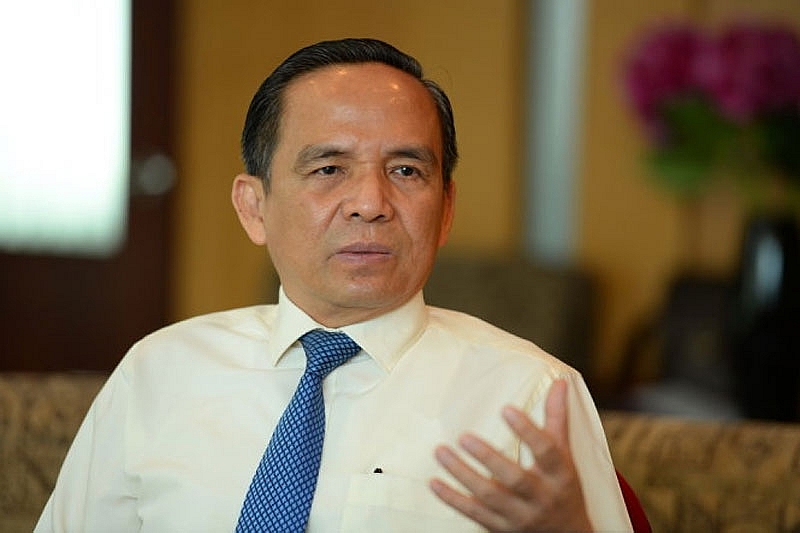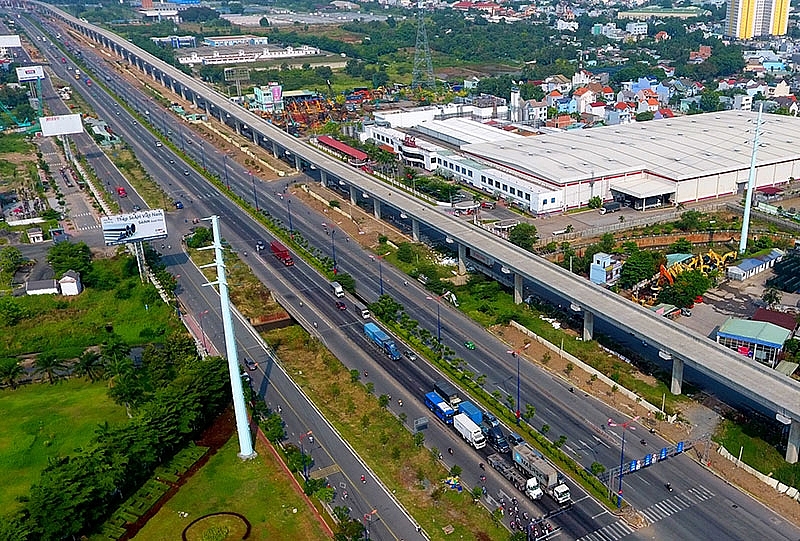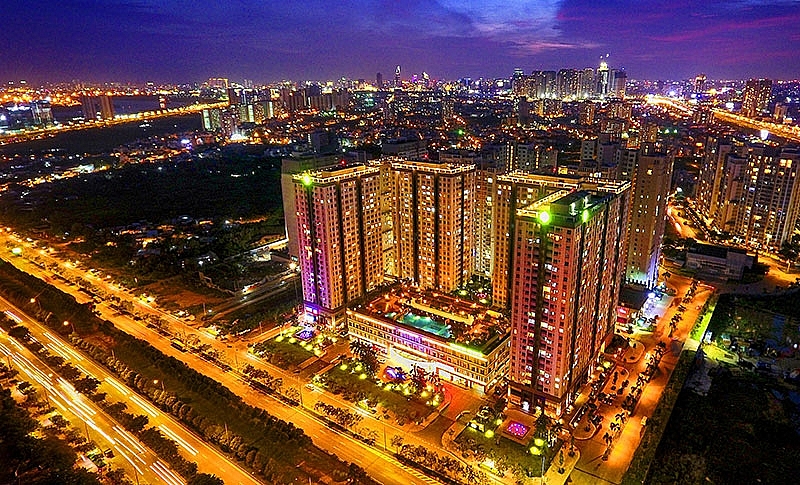Ho Chi Minh City shaping up as a megacity
 |
| Le Hoang Chau - Chariman, Ho Chi Minh City Real Estate Association |
Following a period of slowdown in the local real estate market, in 2015 the Ho Chi Minh City property sector started to gain momentum. In 2016 the entire real estate market encountered a slight dip, but then sprung back again in 2017 with a rather impressive growth of 4.07 per cent on-year, accounting for 0.21 per cent of the total GDP (according to the General Statistics Office). The market is right in the process of being fully restructured and rapidly invested, with focus laid on the development of the affordable housing segment in a bid to meet the actual demand of homebuyers.
The outstanding debts of the real estate sector in Ho Chi Minh City have so far accounted for around 10 per cent of the total outstanding debts in the city, higher than the sector’s national total outstanding debt ratio. Some 10,260 individuals and households, meanwhile, have secured housing support worth up to VND5.244 trillion ($238.36 million).
The stock market has emerged as a new channel for capital mobilisation in recent years, fuelling the real estate market and contributing to the rise of many real estate companies now listed on the local stock exchange like Vingroup, FLC, Novaland, Nam Long, Khang Dien, Coteccons, Hoa Binh, and Dat Xanh.
The flow of foreign direct investment (FDI) into the real estate sector has increased over time. Among the international investors, Japan has become the largest foreign investor in Vietnam and particularly in Ho Chi Minh City. The flow of funds into the real estate sector from the East Asian country has also risen to the top. Overseas remittances received by the city in 2017 have been forecast at $5.2 billion, an increase of 4.5 per cent compared to 2016, and some 22 per cent of the remittances are expected to stream into the property sector.
 |
| Ho Chi Minh City is making huge investments into robust infrastructure development |
Last year, there were 92 housing projects (located primarily in the southern and eastern districts of the city) verified by the Ho Chi Minh City Department of Construction for capital mobilisation. Of these projects, 42,991 units are to be developed, 37,502 of which will be apartments and 5,489 will be villas, shophouses and terraced houses. The total funds required for these projects are estimated at around VND86.4 trillion ($3.92 billion).
Out of the 92 projects, the high-end segment will account for 10,987 units or 25.5 per cent of the total (up 3,747 units or 22.9 per cent compared to 2016). The mid-end segment will take up 45.5 per cent, an increase of 1,081 units or 16.4 per cent compared to 2016. The affordable housing segment will welcome some 12,495 units, accounting for 29.1 per cent of the total units (over 5,000 units or some 67.3 per cent higher than in 2016).
The mid-end and affordable segments account for the largest share of the housing units to be launched in the market in the near future. This could well be a positive signal for the real estate market as property investors and developers have reshaped their product structure to suit the market demand.
The number of affordable housing units, nevertheless, merely adds up to 12,495 in total, a rather petite supply compared to the vast demand arising from government officers, public servants, military officers, and low-income workers.
The real estate market has also witnessed a shift towards green investment which incorporates greenery, lakes, water- and energy-saving features, and environment-friendly facilities into the living environment of many residential urban projects. A few names to mention here include the Phu My Hung township, Sala City, and the Ehome 5 project. Local real estate developers have continued to reiterate their dominance in the segment, taking the lead in various large-scale mergers and acquisitions (M&A) during the year, with a number of renowned businesses, including Vingroup, Novaland, Him Lam Land, FLC, Bitexco, Sun Group, and many others.
 |
| The mid-end housing segment accounts for 45.5 per cent of the new units in the pipeline in Ho Chi Minh City |
Building a megacity
In 2018 the real estate market is forecast to carry on its positive growth path or at least remain stable as seen in 2017. The affordable housing market segment, with 1-2 bedroom units at the price of approximately VND1 billion ($44,000) apiece, is expected to be the main lead of the market this year.
The high-end segment, on the other hand, will go through massive restructuring in a bid to meet the market demand (as in the case of Vingroup and its high-end product Vincity). Meanwhile, the condotel and landed property segments are also predicted to grow rapidly.
Factors that will affect the real estate market this year include a pilot resolution recently passed by the National Assembly aimed for the specific development of Ho Chi Minh City and the city itself has put 19 programmes in place to develop a smart city.
During the period of 2018-2020 the real estate market will continue addressing the supply and demand gap to promote the sustainability of the market in the long term. The gap will be narrowed in a way that more affordable properties are to be built to meet the demand of mid- and low-income earners.
The city is seeking to reassign a third of its land bank designated for agricultural purposes to industrial and residential use. These land areas will then be utilised in developing Ho Chi Minh City into a smart city. The expansion of the city will run through the northwest, becoming the basis for the further development of the real estate market in the medium to long run.
Ho Chi Minh City has a total population of 13 million, three million of whom are migrants from other cities and provinces. The middle-income class is growing rapidly and the GDP per capita is expected to reach $9,800 by 2020, which will in turn boost the demand for residential properties.
The increasing population and the interconnected infrastructure system in the city have led to the expansion of the local real estate market, which now goes beyond the border of the city, extending to the neighbouring provinces, such as Dong Nai, Binh Duong, Long An, and Ba Ria-Vung Tau.
It is also worthwhile to note that a trend of co-operation between real estate enterprises has emerged lately. M&A transactions are anticipated to grow tremendously as a result. Also, thanks to the resolution on resolving bad debts as well as strong FDI and remittance flows into the property sector, the finances needed for the sector’s development are rather plentiful.
Industry 4.0, together with the Internet of Things, artificial intelligence, and green property development are the new trends that property investors and developers ought to take note of to meet the demand of the new generation.
On the note of a property bubble, we believe such an event is unlikely to happen this year as there is timely and effective monitoring by the government to keep things from going ugly.
Through the experience of the past property crises, all stakeholders are smarter now: from the government to investors, property developers, banks, and last but not least, homebuyers themselves.
What the stars mean:
★ Poor ★ ★ Promising ★★★ Good ★★★★ Very good ★★★★★ Exceptional
Themes: Vietnam Property Outlook 2017
Related Contents
Latest News
More News
- JustCo expands business into Vietnam (December 22, 2025 | 17:58)
- Sun Group breaks ground on $2 billion Van Don casino complex (December 19, 2025 | 18:14)
- Rare, beautiful, sustainable: the mark of iconic real estate (December 19, 2025 | 08:00)
- Owner-occupied housing stabilises, paving the way for new growth cycle (December 18, 2025 | 17:04)
- Unlocking urban potential of smart cities (December 18, 2025 | 16:50)
- Green finance offers 'passport' for Vietnamese construction, building materials firms (December 15, 2025 | 08:00)
- Gamuda Land commit long-term investment (December 12, 2025 | 11:49)
- HITC ties up with Evolution to develop AI and hyperscale data centres in Vietnam (December 11, 2025 | 12:09)
- Real estate deals boom via high-profile names (December 08, 2025 | 11:32)
- Industrial segment shaped by M&As (December 08, 2025 | 08:00)

 Tag:
Tag:





















 Mobile Version
Mobile Version